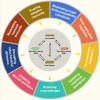Immune escape of avian oncogenic Marek's disease herpesvirus and antagonistic host immune responses
- PMID: 38879650
- PMCID: PMC11180173
- DOI: 10.1038/s41541-024-00905-0
Immune escape of avian oncogenic Marek's disease herpesvirus and antagonistic host immune responses
Abstract
Marek's disease virus (MDV) is a highly pathogenic and oncogenic alpha herpesvirus that causes Marek's disease (MD), which is one of the most important immunosuppressive and rapid-onset neoplastic diseases in poultry. The onset of MD lymphomas and other clinical diseases can be efficiently prevented by vaccination; these vaccines are heralded as the first demonstration of a successful vaccination strategy against a cancer. However, the persistent evolution of epidemic MDV strains towards greater virulence has recently resulted in frequent outbreaks of MD in vaccinated chicken flocks worldwide. Herein, we provide an overall review focusing on the discovery and identification of the strategies by which MDV evades host immunity and attacks the immune system. We have also highlighted the decrease in the immune efficacy of current MD vaccines. The prospects, strategies and new techniques for the development of efficient MD vaccines, together with the possibilities of antiviral therapy in MD, are also discussed.
© 2024. The Author(s).
Conflict of interest statement
The authors declare no competing interests.
Figures


Similar articles
-
Critical roles of non-coding RNAs in lifecycle and biology of Marek's disease herpesvirus.Sci China Life Sci. 2023 Feb;66(2):251-268. doi: 10.1007/s11427-022-2258-4. Epub 2023 Jan 5. Sci China Life Sci. 2023. PMID: 36617590 Free PMC article. Review.
-
Emerging Hypervirulent Marek's Disease Virus Variants Significantly Overcome Protection Conferred by Commercial Vaccines.Viruses. 2023 Jun 25;15(7):1434. doi: 10.3390/v15071434. Viruses. 2023. PMID: 37515122 Free PMC article.
-
Use of Marek's disease vaccines: could they be driving the virus to increasing virulence?Expert Rev Vaccines. 2005 Feb;4(1):77-88. doi: 10.1586/14760584.4.1.77. Expert Rev Vaccines. 2005. PMID: 15757475 Review.
-
Revisiting cellular immune response to oncogenic Marek's disease virus: the rising of avian T-cell immunity.Cell Mol Life Sci. 2020 Aug;77(16):3103-3116. doi: 10.1007/s00018-020-03477-z. Epub 2020 Feb 20. Cell Mol Life Sci. 2020. PMID: 32080753 Free PMC article. Review.
-
The Influence of Major Histocompatibility Complex and Vaccination with Turkey Herpesvirus on Marek's Disease Virus Evolution.Avian Dis. 2015 Mar;59(1):122-9. doi: 10.1637/10677-092413-reg. Avian Dis. 2015. PMID: 26292545
Cited by
-
Protection Conferred by Gallid Alphaherpesvirus 2 Vaccines Against Immunosuppression Induced by Very Virulent Plus (vv+) Marek's Disease Virus Strains in Commercial Meat Type Chickens.Pathogens. 2025 Jan 10;14(1):54. doi: 10.3390/pathogens14010054. Pathogens. 2025. PMID: 39861015 Free PMC article.
-
The MHC (Major Histocmpatibility Complex) Exceptional Molecules of Birds and Their Relationship to Diseases.Int J Mol Sci. 2025 Apr 16;26(8):3767. doi: 10.3390/ijms26083767. Int J Mol Sci. 2025. PMID: 40332403 Free PMC article. Review.
-
The Tiny Epigenetic Addition Plays Big Roles: The RNA Methylation in Both Human and Animal Herpesvirus Infection.Transbound Emerg Dis. 2025 Jul 31;2025:8542827. doi: 10.1155/tbed/8542827. eCollection 2025. Transbound Emerg Dis. 2025. PMID: 40778336 Free PMC article. Review.
-
Rapid-onset cancer.Tumour Virus Res. 2025 Jun;19:200312. doi: 10.1016/j.tvr.2024.200312. Epub 2025 Jan 2. Tumour Virus Res. 2025. PMID: 39755235 Free PMC article. Review.
-
scRNA seq of an F1 cross of Marek's disease resistant and susceptible chickens identifies allele specific expression signatures enriched in transcription modulators.Sci Rep. 2025 Jan 29;15(1):3689. doi: 10.1038/s41598-025-86174-w. Sci Rep. 2025. PMID: 39880866 Free PMC article.
References
-
- Nair, V. et al. in Diseases of Poultry (ed Martine Boulianne David E. Swayne, Catherine M. Logue, Larry R. McDougald, Venugopal Nair, David L. Suarez, Sjaak de Wit, Tom Grimes, Deirdre Johnson, Michelle Kromm, Teguh Yodiantara Prajitno, Ian Rubinoff, Guillermo Zavala) 548-715 (John Wiley & Sons Inc, 2020).
Publication types
LinkOut - more resources
Full Text Sources

